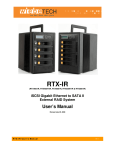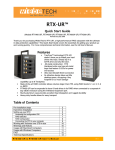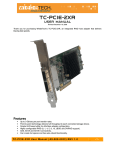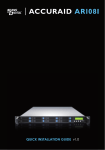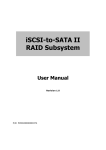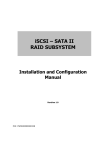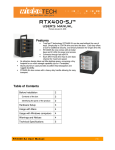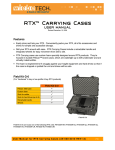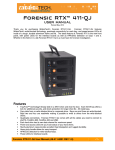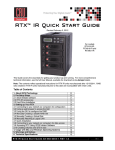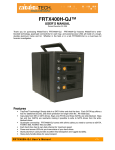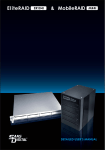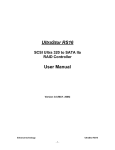Download WiebeTech RTX600H-UR User`s manual
Transcript
RTX-UR™ (RTX400-UR, RTX400H-UR, RTX600-UR, RTX600H-UR & RTX800-UR) ULTRA-320 SCSI to SATA Disk Subsystem User’s Manual Revised July 29, 2008 RTX-UR User’s Manual -1- WiebeTech LLC WARRANTY The information in this document is subject to change without notice. We make no warranty of any kind regarding this material, including, but not limited to, the implied warranties or merchantability and fitness for a particular purpose. Furthermore, we shall not be liable for errors contained herein or for incidental or consequential damage in connection with the furnishing, performance, or use of this material. Introduction About this Manual Thank you for choosing WiebeTech products. If you have any questions, please e-mail [email protected] or call our tech support. This manual is designed and written for users of the RTX-UR. Users should ideally be familiar and have some experience with RAID planning and data storage operations. However, this manual will provide instructions and education for those who have little or no experience in RAID to install and setup the RTXUR. Notice Product features and specifications described in this manual are subject to change without notice. The manufacturer shall not be liable for any damage, or for the loss of information resulting from the performance or use of the information contained herein. Trademarks All contents of this manual are copyrighted by WiebeTech LLC. The information contained herein is the exclusive property of WiebeTech LLC and shall not be copied, transferred, photocopied, translated on paper, film, electronic media, or computer-readable form, or otherwise reproduced in any way, without the express written permission of WiebeTech LLC. Copyright@2008, WiebeTech LLC All rights reserved. RTX-UR User’s Manual -2- WiebeTech LLC Table of Contents Chapter 1: Introduction to RAID Chapter 2: Pre-Installation 2.1 RTX accessories 2.2 RTX parts Chapter 3: Hard Drive Installation Chapter 4: Configuration 4.1 Connect the RTX to your network (or computer) for configuration 4.2 Use the LCD to configure the LAN GUI port 4.2.1 Navigating the LCD menu 4.2.2 LCD functions 4.2.3 RTX-UR LCD Menu Diagram 4.2.4 If you are connected to a DHCP-enabled network 4.2.5 If you are connected to a static network 4.2.6 If you are connected directly to a computer Chapter 5: Using the GUI 5.1 GUI indicators 5.2 Overview of GUI architecture 5.3 Quick Install 5.4 System Config 5.4.1 System name 5.4.2 IP address 5.4.3 Language 5.4.4 Login Config 5.4.5 Password 5.4.6 Date 5.4.7 Mail 5.4.8 Simple Network Management Protocol (SMNP) 5.4.9 System Log Server 5.4.10 Event Log 5.5 Volume Config 5.5.1 Physical Disk 5.5.2 Volume Group (VG) 5.5.3 User Data Volume (UDV) 5.5.4 Cache Volume 5.5.5 Logical Unit 5.6 Enclosure Management 5.6.1 SES Config 5.6.2 Hardware Monitor 5.6.3 S.M.A.R.T. 5.7 Maintenance 5.7.1 Upgrade 5.7.2 Info RTX-UR User’s Manual 5 6 6 6 7 8 8 8 8 9 9 10 10 10 11 11 12 12 13 13 13 14 14 14 14 16 16 16 17 17 18 19 20 22 22 23 23 23 24 24 24 24 -3- WiebeTech LLC 5.7.3 Reset to default 5.7.4 Config Import & Export 5.7.5 Shutdown 5.8 Quick Set-up of RAID 5.9 Connecting to your Computer Chapter 6: Formatting new volume(s) Appendix A. Certification list Appendix B. Event notifications Appendix C: Working with Volumes over 2TB in size Appendix D: Warnings and Notices Appendix E: Frequently Asked Questions (FAQ) Appendix F: Technical Specifications RTX-UR User’s Manual 25 25 25 25 25 26 27 28 30 31 31 32 -4- WiebeTech LLC Chapter 1: Introduction to RAID A RAID (Redundant Array of Independent Disks) is an array of multiple hard drives that are combined in a way that provides faster performance and/or data safety. Your RTX unit is capable of creating and managing several different varieties of RAID. You may choose your preferred RAID level based on factors such as disk capacity, desired data safety, and desired performance. Summary of RAID Levels The RTX supports RAID Levels 0, 1, (0+1), 3, 5 and 6. RAID level 5 is most commonly used by those seeking an optimal balance of speed and data safety. RAID Features and Performance RAID Level 0 1 0+1 3 5 6 Description Also known as striping. Data distributed across multiple drives in the array. There is no data protection. Also known as mirroring. All data replicated on separated disks. RAID 1 is almost always 2 disks. This is a high availability solution, but due to the 100% duplication, it is also a costly solution. Also known as Block-Interleaved Parity. Data and parity information is subdivided and distributed across all disks. Parity must be equal to the smallest disk capacity in the array. Parity information normally stored on a dedicated parity disk. Also known as Bit-Interleaved Parity. Data and parity information is subdivided and distributed across all disks. Parity must be equal to the smallest disk capacity in the array. Parity information normally stored on a dedicated parity disk. Also known as Block-Interleaved Distributed Parity. Data and parity information is subdivided and distributed across all disks. Can withstand the failure of one drive, and 80& of drive capacity is usable. Two different parity bits are used, to create double redundancy. Can withstand the failure of two drives, but only 60% of drive capacity is usable. RTX-UR User’s Manual Min. Drives Max. Drives Data Reliability Data Transfer Rate 1 8 No data Protection Very high 2 2 Lower than RAID 6; Higher than RAID 3, 5 Reads are higher than a single disk; Writes are similar to a single disk 3 8 Lower than RAID 6; Higher than RAID 3, 5 Transfer rates are more like RAID 1 than RAID 0 3 8 Lower than RAID 1, 10, 6; Higher than a single drive Reads are similar to RAID 0; Writes are slower than a single disk 3 8 Lower than RAID 1, 10, 6; Higher than a single drive Reads are similar to RAID 0; Writes are slower than a single disk 4 8 Higher than 1,10, 5 Slightly less than RAID 5 -5- WiebeTech LLC Chapter 2: Pre-Installation 2.1 RTX accessories Check the accessories with your RTX-UR. Please contact WiebeTech if any parts are missing or damaged. The box should contain the following items: RTX400-UR, RTX400H-UR & RTX600H-UR Accessories Quantity RTX600-UR & RTX800-UR Accessories Quantity SCSI Cable 1 SCSI Cable 1 RS-232 Configuration Cable 1 RS-232 Configuration Cable 1 Power Cable 1 Power Cable 1 Packet of Keys 1 Terminator Terminator 1 Manual and Warranty Info Manual and Warranty Info 1 (on CD) (on CD) 2.2 RTX Parts Take a moment to familiarize yourself with the parts of your new product. This will help you to better understand the remaining instructions. LCD Panel on front of RTX LCD Power LED Up ESC (Escape, Exit) IP Address Access LED RTX-UR User’s Manual Alarm LED Down ENT (Enter) -6- WiebeTech LLC Key lock Hardened Bay Rear Panel Power LED Key lock Access LED Ejection handle 8cm Fan SCSI Ports Standard Bay RS-232 Power LED Access LED Ejection handle Infiniband Expansion Ethernet Port (400 models only) (configuration only) Basic Bay Power LED Power Switch Power Outlet Ejection handle Access LED WARNING: Do not block the ventilation fan during operation. Overheating may damage the device or hard drives. All RTX TrayFree Bays accept 1TB SATA drives, have power and access LEDs, and connect to the host via a SATA connection. Chapter 3: Hard Drive Installation If you purchased your RTX with pre-configured drives, you may skip to the next section. Install a SATA (Serial-ATA) hard drive into each bay. With TrayFree™ technology, this process couldn’t be easier! Simply pull the ejection handle to open the bay door, slide in your SATA drive, and shut the door behind it. The drive is inserted with the label up and the SATA NOTE: If any of the drives are inaccessible after connection on the drive inserted first. powering on the unit, try the following steps: With the RTX400 & RTX600H, you can 1. Turn off the power. 2. Remove the drive(s) in question. lock the bay for additional security, but 3. Reinsert the drive(s). make sure to unlock it before pulling on 4. Turn on the power. the ejection handle again. RTX-UR User’s Manual -7- WiebeTech LLC Chapter 4: Configuration 4.1 Connect the RTX to your network (or computer) for configuration. a. Plug an ethernet cable into the “LAN GUI” port on the rear of the RTX. b. Connect the other end of the ethernet cable to your network. Usually, this means plugging it into a router or hub. In an office environment, you may have a network jack built into your office wall. If a network connection is not available, you can connect the ethernet cable directly to an RJ45 (ethernet) port on your computer. c. Connect the power cable to the rear of the RTX and to a grounded electrical outlet. d. Turn on the RTX unit’s power using the switch on the rear panel. 4.2 Use the LCD to configure the LAN GUI port RTX has both an LCD interface and a GUI. The LCD interface has only basic functionality and is mainly used to configure the IP address of the LAN GUI port. Once the LAN GUI has been configured, the GUI can be used to fully configure the RTX. 4.2.1 Navigating the LCD menu Use the four function keys, ▲ (Up), ▼ (Down), ESC (Escape) and ENT (Enter) to manipulate the LCD interface. After pressing ENT (Enter) key, you can use the ▲ (Up) and ▼ (Down) keys to select a function. If there is an alarm or error message, the LCD will display the related information. RTX-UR User’s Manual -8- WiebeTech LLC 4.2.2 LCD functions: Alarm Mute To turn off the alarm sound when an error occurs Reset/Shutdown To reset or shutdown the controller To use “Quick Install” to set up a volume by three steps. Please refer to section 4.3 Quick Install for configure via the web-based GUI View IP Setting To view current IP address, subnet mask and gateway To set up the IP address, subnet mask and gateway. You can choose to use DHCP Change IP Config server (for IP address allocation) or manually specify the IP address To restore factory defaults: Default Password: 1234 Reset to Default Default IP address: 192.168.0.1 Default subnet mask: 255.255.255.0 Default gateway: 192.168.0.254 4.2.3 RTX-UR LCD Menu Diagram Use the following chart for reference when following the instructions in 5.2.4 through 5.2.7 for setting up the RTX according to your network type. Main Menu nd rd 2 Menu Screen 3 Menu Screen [Alarm Mute] [▲Yes No▼] [Reset] [Reset/Shutdown] [Shutdown] [Quick Install] [View IP Setting] WiebeTech RTX RAID 0 (RAID 1/RAID 3/ RAID 5/RAID 6) xxxxxx MB [IP Config] [Static IP] [IP Address] [192.168.000.001] [IP Subnet Mask] [255.255.255.0] [IP Gateway] [192.168.000.254] [DHCP] [Change IP Config] [Static IP] th 5 Menu Screen [▲Yes No▼] [▲Yes No▼] Volume Size (xxxxxx M) Apply The Config Adjust Volume Size [▲Yes No▼] [▲Yes No▼] [IP Address] [IP Subnet Mask] [IP Gateway] [Apply IP Setting] [Reset to Default] RTX-UR User’s Manual th 4 Menu Screen Adjust IP address Adjust Submask IP Adjust Gateway IP [▲Yes No▼] [▲Yes No▼] -9- WiebeTech LLC 4.2.4 If you are connected to a DHCP-enabled network On DHCP networks, a new IP address is dynamically assigned to the RTX’s LAN GUI port as soon as the network detects it. You can determine this address by checking the LCD interface on the front of the RTX. It will appear in this format: xxx.xxx.xxx.xxx. Simply type this IP address into a web browser on your computer. This will access the RTX’s GUI, which you will use to configure the unit. 4.2.5 If you are connected to a static network a. Check your computer’s IP address. To do this in Windows, open Network Connections in the Control Panel. Double-click on your network and then click on the Support tab. Your computer’s IP address will be displayed. Mac users can find this information in System Preferences Network. b. On the RTX’s LCD interface, press ENT and then scroll up or down to Change IP Setting. Press ENT. c. Scroll up or down to find Static. Press ENT. d. Change the IP address to closely match what your computer is using. For example, if your computer's IP address is 192.168.000.009 you could change the RTX's IP to 192.168.000.007. Everything but the last set of three digits must be the same! When changing the IP address you'll notice that a box flashes over the digit to be changed. While the digit is selected, press up or down to change it. Press ENT to move to Not sure what type of network you the next digit. After the IP is set, press ENT all the way have? If the IP address displayed on the to the end and confirm the settings change. To confirm, LCD starts with 169.254 or 192.168, this indicates that the network is probably not press up for “yes” and then press ENT again. DHCP-enabled. Use the instructions for e. Type the RTX’s new IP address into a web browser a static network. on your computer. This will access the RTX’s GUI, which you will use to configure the unit. 4.2.6 If you are connected directly to a computer The instructions are similar to those for a static network (see 5.2.2), except that your computer will not have the IP address assigned if it’s not a part of a network. Since the RTX and your computer must have similar IP addresses, you will assign an IP address to your computer based on the default IP address of the RTX. a. Check the RTX’s LCD to find out the IP address of the LAN GUI configuration port. It will appear in this format: xxx.xxx.xxx.xxx. b. Next, change your computer’s IP address so that all but the last three digits match the RTX’s address. For example, if the RTX’s IP is 169.254.12.62, you might assign your computer the number 169.254.12.63 (assuming no other computer on the network is already using that number). The process of changing your computer’s IP address varies depending on its operating system. (For Windows XP, open Network Connections in the Control Panel. Right-click on your network and select Properties. On the new window that opens, select TCP/IP and click the Properties button. Mac users can go to System Preferences Network.) By default, your computer is probably set to receive a new IP address automatically. Change the setting to manual configuration and then type in the IP address. c. Using the same process as the previous step, change the computer’s Mask setting to match the RTX’s Mask setting. d. Finally, use the LCD interface to change the RTX’s Gateway setting. It should match the IP address you assigned to your computer. e. Launch a web browser and type the RTX’s IP address into the URL bar, as if it were a website. This will access the RTX’s GUI, which you will use to configure the unit. The tables below show example settings. The table on the left shows the type of settings that will appear by default. The table on the right shows how the settings might look after you’ve made changes. IP Address Mask Gateway RTX Computer 169.254.12.62 255.255.000.000 000.000.000.000 (blank) (blank) (blank) Before making changes RTX-UR User’s Manual IP Address Mask Gateway RTX Computer 169.254.12.62 255.255.000.000 169.254.12.63 169.254.12.63 255.255.000.000 (blank) After making changes - 10 - WiebeTech LLC Chapter 5: Using the GUI You will use the web browser-based GUI to set up a RAID and create logical volumes on the RTX. After accessing the GUI (see step 5.2), the GUI’s main page should load, displaying a picture of the RTX with several options to the left. When you click on any option, you will be prompted for a user name and password. The user name is "admin" and the default password is "1234." 5.1 GUI indicators The top right hand corner of the GUI window displays several indicators. RAID light: Green indicates the RAID is working properly. Red indicates a RAID error. If no RAID is set up, the light will remain green. Temperature light: Green indicates normal. Red indicates abnormal system temperature, such as overheating. Voltage light: Green indicates normal. Red indicates abnormal voltage status, such as a power surge or a bad power supply. RTX-UR User’s Manual - 11 - WiebeTech LLC 5.2 Overview of GUI architecture Quick Install → Step 1 / Step 2 / Step 3 / Confirm System Configuration System Name → IP Address → SCSI → Log Config → Password → Date → Mail → SNMP → Event Log → System name DHCP / Static SCSI bus setting Auto Logout / Login Lock Old password / Password / Confirm Date / Time / Time zone / Daylight saving Mail-from address / Mail-to address / SMTP relay / Authentication / Send test mail SNMP trap address / Community Mute / Clear / Download Volume Configuration Physical Disk → Volume Group → User Data Volume → Cache Volume → Logical unit → Free disc / Global spares / Dedicated spares / More information Create / Delete / More information / Rename / Migrate Create / Delete / Attach LUN / Snapshot / More information / Rename / Extend / Set read/ write mode / Set priority / Resize Snapshot space / Auto Snapshot Create / Delete / More information / Resize Attach / Detach Enclosure Management SAF-TE Config → Hardware Monitor → S.M.A.R.T. → Enable / Disable Item / Information / Confirm S.M.A.R.T. for physical disks Maintenance Upgrade → Info → SCSI → Reset to default → Config Import & Export → Shutdown → Browse the firmware to upgrade System information SCSI SAF-TEsions and connections Reset to factory default Import / Export / Import File Reboot / Shutdown Logout 5.3 Quick Install WiebeTech does not recommend using the Quick Install option to set up your RTX-UR. For quick set-up of a RAID, refer to section 5.8 or the QuickStart Guide on your WiebeTech CD. RTX-UR User’s Manual - 12 - WiebeTech LLC 5.4 System Config The System Config menu gives access to a number of options used to configure the RTX-UR system properties. Click on “System Config” to access the following menu options: System name, IP address, Language, Login config, Password, Date, Mail, SNMP, System Log Server, and Event Log. 5.4.1 System name Clicking on the “System name” option allows you to view and change the system name. The default system name is “RTX-UR-<individual serial number>.” Note that this serial number is different from the one on the outside of the product, and is not the one that should be used to contact technical support. To change the system name, simply click in the box displaying the system name and highlight or delete the part of the name you wish to change, then type the new name and click “Confirm.” 5.4.2 IP address The IP address option allows you to view and modify the IP information of the LAN GUI port of the RTXUR. Note that this is not the option used to configure the IP address of the data ports. An RTX-UR configured for DHCP. Some of the information has been obscured for security reasons. RTX-UR User’s Manual - 13 - WiebeTech LLC 5.4.3 Language The Language option allows you to change the language of the GUI menu. To change the language, click the drop down menu, select your choice, and then click the “Confirm” button. 5.4.4 Login Config The login configuration features are “Auto Logout” and “Login Lock.” Auto Logout allows you to set a time of 5 minutes, 30 minutes, or 1 hour to automatically log the user out of the GUI. Login Lock prevents multiple users from using the GUI simultaneously. Both features are disabled by default. To enable a feature, click on the dropdown menu associated, select the new option, and then click the confirm button. 5.4.5 Password The Password option allows you to change the administrative password used to access the GUI. (Recall that the default user name and password is admin/1234.) To change the password, enter the old password in the first field, then type the new password in the second and third field and click the “Confirm” button on the right side of the screen. A dialog box will appear asking for verification. Click “OK.” After the password has been changed, another dialog box will appear to inform you that the password has been changed. 5.4.6 Date The Date option allows you to change the date and time settings of the RTX-UR. The default settings are the Asia/Taipei time zone: To change the date or time, click in the field that you wish to change and highlight or delete the information, then type the new information and click confirm. To change the time zone, click the drop down box and then scroll up or down until you reach the correct time zone, then choose that time zone RTX-UR User’s Manual - 14 - WiebeTech LLC and click confirm. After confirming, a dialog box will appear verifying that changes have been made. Alternatively, an NTP (network time provider) can be used to sync the RTX-UR’s time information with that of a standardized server. To use an NTP, click the NTP check box, then input the server information in the server field. Click confirm to update the time settings. A dialog box will appear to inform you that the changes have been made. The updated settings will reflect the time settings of the NTP: RTX-UR User’s Manual - 15 - WiebeTech LLC 5.4.7 Mail RTX-UR can be configured to send email to up to 3 addresses when events, warnings, and errors occur. Contact your IT administrator to set up an email address for RTX-UR and to input the proper SMTP settings. 5.4.8 Simple Network Management Protocol (SMNP) SNMP can be configured to send trap messages to up to three different addresses on the network. To add an address, simply enter the IP address of the receiving server or computer, then click confirm. Note: The receiving server must be configured to receive SMNP messages. For more information on SMNP, you may wish to consult the third party website: http://www.techfaq.com/snmp.shtml 5.4.9 System Log Server The System Log Server option allows configuration for error, warning, and information reporting via a certain port on the server. Enter the server IP in the first line and the port used in the second line (default 514). The facility can be changed between User and Local1 through Local7 using the dropdown box. Select the check boxes for Info, Error, and Warning that pertain to the information that you want to be reported. RTX-UR User’s Manual - 16 - WiebeTech LLC 5.4.10 Event Log The Event Log allows you to display and download event messages. To configure what type of messages are displayed click the Filter button. By default, errors and warnings will be displayed on both the LCD of the unit itself and in the GUI. Use the checkboxes to configure how the information is displayed. Click the Download button to download the entire event log as a text file. Click the Clear button to clear the entire event log. Click the Mute button to stop system alerts. 5.5 Volume Config The Volume Config menu provides the options you will use to set up a RAID on the RTX-UR. Click on Volume Config to view the following menu options: Physical Disk, Volume Group, User Data Volume, Cache Volume, and Logical Unit. RTX-UR User’s Manual - 17 - WiebeTech LLC The following diagram explains the architecture of RAID using RTX-UR and the relationship between physical disks (PDs), volume groups (VGs), user data volumes (UDVs), and logical unit numbers (LUNs). One VG (Volume Group) consists of a set of UDVs (User Data Volume) and owns one RAID level attribute. Each VG can be divided into several UDVs. The UDVs from one VG share the same RAID level, but may have different volume capacity. If multiple UDVs are created, they will mount on your computer as separate partitions. Each UDV will be associated with one specific CV (Cache Volume) to execute data transfers. Each CV could have different cache memory size as defined or configured by user. LUN is a SCSI protocol that the computer uses to distinguish and access SCSI devices. 5.5.1 Physical Disk Click the Physical Disk option to view and modify the status of the drives installed in the RTX-UR. The following information is displayed: • Checkboxes: Click the checkbox of any disk or disks, then click Free disks, Global spares, or Dedicated spares to set the selected drive(s) to that status. Click the top checkbox to select all drives. • Slot: The slot number of the hard drive. 1 corresponds to the top bay of the RTX-UR. Click the button below the slot number to display more information about that particular hard drive. • WWN: The World Wide Name of the hard drive, an identification code unique to each hard drive. • Size (GB): The logical capacity of the drive. • VG (name): The Volume group the drive is assigned to, if any. RTX-UR User’s Manual - 18 - WiebeTech LLC Status: Displays general operational status of the disk. Possible states are Good, Defect, and Fail. • 1: Displays the RAID status of the disk. Possible states are: o RD – RAID Disk. The drive is part of a RAID that is currently online. o FR – Free disk. The drive is available for use in a volume group, or to be marked as a spare. o DS – Dedicated spare. The drive is a dedicated spare of a specific volume group. This option cannot be selected until at least one volume group has been created. o GS – Global spare. The drive is a global spare of all VGs. o RS – Reserve. The drive contains VG information but cannot be used. This generally indicates that the drive is part of a RAID set that is missing components. • 2: Displays RAID rebuild status of the disk. Possible states are “R” – Rebuild, or “M” – migration. • Speed: The maximum speed of the drive. 1.5 Gbps indicates a SATA1 drive, 3.0 Gbps indicates a SATA2 drive, and unknown indicates that the drive does not support either of the two levels. Auto spindown: If auto spindown is enabled, after a set amount of time (30 seconds, 1 minute, 5 minutes, or 30 minutes) of inactivity, RTX-UR will spin down the hard drives to save power. The drives will be spun up again when the RTX-UR is accessed. Auto spindown is disabled by default. To enable auto spindown, click the hyperlink “disabled.” On the following screen, select the desired auto spindown time from the dropdown box: • Click the Confirm button. 5.5.2 Volume Group (VG) The Volume Group screen displays information about all existing volume groups. To create a usable RAID set, you will first need to create a new Volume Group. Click the Create button. This brings up the VG creation screen. Enter a name for the new VG in the first field then select your desired RAID type from the dropdown box. WiebeTech recommends RAID5 for maximum performance, capacity, and security. For more information on RAID, see Chapter 1: Introduction to RAID. Click Select PD to select the drives that will be added to the VG. Note: Drives must be marked as Free Disks (FR) before they can be added to a VG. To set drives to Free Disks, see section 5.5.1. All available Free disks will be displayed. Check the drives that you wish to add to the VG, then click Confirm. RTX-UR User’s Manual - 19 - WiebeTech LLC The selected PDs will now be displayed in the VG creation screen. Click next to proceed. This brings you to a confirmation screen. Verify that the RAID level is correct and all of the disks you selected are displayed under “RAID PD slot,” then click confirm to create the VG. The VG will now display on the main VG screen. The VG screen displays the following information: • No: The VG number. Click the button underneath the number of a VG to view more information. • Name: The name of the VG. Click the button below a VG’s name to rename the VG. • Total (GB): The total capacity of the VG. Note: This will depend on both the number and capacity of the drives that are part of the VG, and the RAID type of the VG. • Free (GB): The free capacity of the VG (not yet assigned to a UDV). • #PD: The number of drives in the VG. • #UDV: The number of UDVs that have been created as part of the VG. • Status: The status of the VG. Possible states are Online and Fail. • 1: Displays “DG” if the VG is degraded. This generally means a hard drive is missing or has failed. • 2: Displays “R” if the VG is rebuilding. • 3: Displays “M” if the VG is under migration. • RAID: The RAID level of the volume group. The button underneath the RAID setting indicates “migrate,” but it is recommended that if you wish to change RAID types or add disks, you simply recreate the VG using the new RAID type as this is generally faster. 5.5.3 User Data Volume (UDV) The User Data Volume main screen displays any UDVs and allows you to create and delete UDVs. After a VG has been created, you can create associated UDVs. You must create at least one UDV to access the drives of the RTX-UR with a computer. To begin this process, click Create. This brings up a screen displaying the following: RTX-UR User’s Manual - 20 - WiebeTech LLC • • • • • • • • Name: Enter a name for the UDV VG name: Choose the VG that you wish to add the UDV too. CV no.: Cache Volume number – if you have created multiple caches, you can select between them. Normally the default option is preferred. Capacity: Enter the capacity of the UDV. The default uses the maximum capacity of the associated VG. If you wish to create multiple UDVs on the selected VG, you will need to reduce the capacity below the maximum so that there is space left on the VG for additional UDVs. Stripe height (KB): Determines how the RTX-UR organizes the RAID. Normally the default option is preferred. Block size: Determines the minimum file size of the UDV. Higher block sizes can result in more wasted space if many small files are saved to the drive, but are necessary to take advantage of high capacity RAIDs. If you are creating a UDV over 2 TB in size, you must increase the block size to 4096 to take advantage of the full capacity of the UDV. For more information, see the Appendix, “Working with Volumes Greater than 2 TB” Read/Write: Allows selection of cache type. Normally the default option is preferred. Priority: Determines the priority that RTX-UR will give to RAIDing activities (rebuild, initialization) versus priority given to file transfers. High priority will result in slower file transfers during initialization, but provide for faster initialization. After selecting your desired options, click Confirm. The new UDV will now display on the main UDV screen: The main UDV screen displays the following information: • No.: The number of the UDV. Click the button below the number of a UDV to view more information about that UDV. • Name: The name of the UDV. Click the button below a UDV’s name to rename it. • Size: The total capacity of the UDV. Click the button below the displayed size of a UDV to add capacity to the UDV. Note: There must available space on the VG to extend the UDV. • Status: The status of the UDV. Possible states are Online and Fail. • 1: Displays the cache mode of the UDV. “WT” indicates that the cache is set to write through, while “WB” indicates write back mode. Click the button below the cache mode to change the cache mode. • 2: Displays the priority of RAID functions for the UDV. Possible states are HI, MD (medium), and LO. Click the button below a UDV’s priority to change the priority. • 3: Displays the RAID activity of the UDV. “I” indicates that the UDV is initializing a RAID, “R” indicates that the UDV is rebuilding a RAID, and “M” indicates that the UDV is under migration between RAID types. • R %: Displays progress of the activity indicated in column “3.” Note: Initializing a RAID5 may take RTX-UR User’s Manual - 21 - WiebeTech LLC • • • • several hours. RAID: The RAID level of the UDV. This was chosen during the VG creation. #LUN: Number of LUNs that the UDV is using. 1 LUN must be attached before use with a computer. See section 6.6.5 for more information on attaching a LUN. VG name: The name of the VG associated with the UDV. CV (MB): The cache volume of the UDV. 5.5.4 Cache Volume The Cache volume screen allows the creation and management of multiple caches. By default, a global cache using all of the cache memory is created and automatically assigned to all UDVs created. The cache volume screen displays the following information: • No.: The number of the cache. Global cache is always first. Click the button below to view more information. • Size: The size of the cache. By default, the global cache uses all available cache space. If you wish to create additional caches, you must click on the button below the size of the global cache and enter a number lower than the maximum value, then click Confirm. This frees up space to create a new cache. Now click Create, enter the desired size of the new cache, and click Confirm. The new cache will now be an option under “CV No.” when creating a new UDV. • UDV name: The name of the UDV associated with the cache. Global is default for all UDVs. 5.5.5 Logical Unit The Logical Unit is what your computer will use to access and manage SCSI devices. In order to access a UDV, you will need to attach a Logical Unit Number (LUN) to that UDV. To attach a LUN, click the Attach button: The following options are available: • UDV: Choose the UDV to which you wish to attach a LUN. • Host: The Host field is filled with an asterisk by default, meaning that any host can access the UDV. You may change the field if you wish to limit access to specific hosts. • LUN: The LUN field allows you to select which LUN to attach to the UDV. The default option is normally acceptable. • Permission: Choose Read-write or Read-only for accessing the UDV. RTX-UR User’s Manual - 22 - WiebeTech LLC Click Confirm after selecting your desired settings. The main Logical Unit Screen will now display the LUN you have just created: 5.6 Enclosure Management Enclosure management gives access to the following menu options: SES config, Hardware Monitor and SMART. 5.6.1 SES Config SCSI Enclosure Services, or SES, is a command set that is used to manage and sense the state of the power supplies, cooling devices, displays, indicators, and individual drives of a SCSI device. The RTXUR is an SES compliant enclosure, however, in order to use manage RTX-UR using SES you must have the appropriate software installed on your computer. An example is SMART Monitor, offered by Santools at www.santools.com. To enable SES on your RTX, you must have a UDV set up and a LUN attached. Once you have done this, navigate to SES Config and simply click the Enable button, then click Confirm. The SES-enabled LUN will show up on the main SES screen. 5.6.2 Hardware Monitor The Hardware Monitor displays information about the voltages and temperatures of the RTX-UR. Auto shutdown feature: When this checkbox is enabled, the RTX-UR will automatically shut down if any of RTX-UR User’s Manual - 23 - WiebeTech LLC the voltages or temperatures displayed stray outside of the minimum or maximum values. Auto shutdown is enabled by default to protect the hardware of the RTX-UR. 5.6.3 S.M.A.R.T. S.M.A.R.T. (Self-Monitoring Analysis and Reporting Technology) is a diagnostic tool for hard drives that gives advanced warning in some cases of hard drive failure. S.M.A.R.T. measures various attributes of a hard drive at all times to detect if certain values have moved outside of a certain range. The S.M.A.R.T. option allows you to view the S.M.A.R.T. status of all of your hard drives. 5.7 Maintenance The maintenance screen gives access to the firmware and configuration functions: Upgrade, Info, Reset to default, Config import & export, and Shutdown. 5.7.1 Upgrade The upgrade function allows you to upgrade the firmware of the RTX-UR. DO NOT USE THIS FUNCTION WITHOUT SPECIFIC INSTRUCTION FROM WIEBETECH TECHNICAL SUPPORT. Doing so could result in malfunction of your RTX-UR. 5.7.2 Info Click on Info to display system information: 5.7.3 Reset to default RTX-UR User’s Manual - 24 - WiebeTech LLC The Reset to Default option allows you to restore settings to the factory defaults. After clicking Reset to Default, you will need to click Confirm to verify. 5.7.4 Config Import & Export The config import & export function allows you to import or export a firmware config file. DO NOT USE THIS FUNCTION WITHOUT SPECIFIC INSTRUCTION FROM WIEBETECH TECHNICAL SUPPORT. 5.7.5 Shutdown The Shutdown feature allows you to shutdown or reboot the RTX-UR’s RAID controller and LCD controller. Note: Choosing Shutdown will not shut down the physical components of the RTX-UR (fans, drives, power supply). However, it will flush data from the cache to the physical drives, which is recommended before physically shutting down using the power switch on the unit to prevent data corruption. 5.8 Quick Set-up of RAID Follow these instructions to quickly create a RAID set using the GUI: a. Click on Volume Config, then Volume Group. b. Choose Create. Select the RAID level you would like to use (usually RAID 5). If there is an error saying "Disk is not enough" you'll need to go to Physical Disk, select all of the disks you wish to include in the Volume Group, and press the Free Disk button. c. Click on Select PD. Select all the hard drives you wish to put into the new RAID.* You’ll need NOTE: If the total capacity of your volume exceeds 2TB, it is likely you will encounter problems using that to confirm your choice. volume on most current operating systems. If that is the d. Next, go to User Data Volume (UDV) and case, you will most likely wish to divide the capacity into choose Create. Select the capacity you want two or more volumes of less than 2TB each. Please for this UDV. (See note at right.) see the section labeled, "Working with volumes > 2TB." e. The rest of the details can be left at the default setting. You’ll need to confirm several times. f. You should wind up back at the main UDV screen. The RAID will begin initializing, and progress will be displayed in the R% column. Depending on the RAID type and size, the initialization could take several hours. The R% number will disappear when the initialization has finished. Note: some RAID types initialize almost instantaneously, so you may not see a progress meter. g. Select the check box next to the UDV you just created and then click Attach. If you created more than one volume, you’ll need to repeat this step for each one. h. Use the default settings on the next screen. You’ll need to confirm your selections. * With the RTX400-UR, the number of drives contained in the RAID group can be as high as eight using the Infiniband expansion port on the rear of the unit. This port allows you to connect another 4-bay JBOD eSATA enclosure (e.g. RTX400-SJ), or multiple 1-bay eSATA drive enclosures and add those additional drives to the RTX400-UR’s RAID. Note: These additional drives must be added at the time the RAID is first created. 5.9 Connecting to your computer a. First, make sure your computer is turned off. Plugging a SCSI cable into a live host could cause damage to the host. Besides, since SCSI is not hot-swappable your computer would not see the RTX until it is restarted. RTX-UR User’s Manual - 25 - WiebeTech LLC b. Connect the SCSI cable to one of the channels on the back of the RTX. Connect the other end to the host computer. If your computer does not have an available SCSI port, you will need to install a SCSI host bus adapter (HBA). If the SCSI port on your computer is a different type and the cable will not fit, you may need to use an adapter. Install a terminator in the other port of that channel NOTE: If you are using a SCSI host card that would normally support RAID functionality, you will need to disable any and all RAID settings on the card for the RTX to be detected. If you cannot disable the RAID settings, select JBOD mode. c. Connect the power cord to the RTX and a grounded electrical outlet. d. Turn on the RTX. After it is started up and ready, turn on your computer. If you turn on the computer first, it will not be able to see the RTX. Chapter 6: Formatting new volume(s) If you did not purchase the RTX with preconfigured drives, before using them. This is typically done using tools built in to your computer’s operating system. (For example, Disk Utility for Mac OS X or Disk Management for Windows.) Consult your computer’s operating manual for details. you will need to format the new volume(s) NOTE: When formatting a volume larger than 2TB in Windows Vista, you may be prompted to select either MBR or GPT for initialization. MBR will truncate the volumes to 2TB each, creating multiple partitions if necessary. GPT will allow volumes over 2TB, but is not compatible with all previous versions of Windows. Usage with Macintosh computers Mounting and Ejecting Volumes When you connect the unit to the Mac for the first time and turn on the power, you’ll probably see a message saying that the disk is unreadable. This is because you must format the volume before using it. The easiest way to do this is to use Mac OS X’s Disk Utility. If you plan to use the unit on both Macs and PCs, select “MS DOS File System” as the format type. If you only plan to use the unit on Macs, then select “Mac OS Extended”. After the volume is formatted, an icon representing the drive volume will appear (“mount”) on the desktop. You can now use the volume just like an internal hard drive. Eject the volume before powering down the unit by dragging the volume’s icon to the trash bin, or by selecting the volume then pressing Command-E. Shutting down the unit without first ejecting the volume can result in data loss. Usage with Windows computers Formatting Volumes Before you can use your RTX-UR, you must first format the drives into a volume. Use Disk Management, which you can find by right-clicking on My Computer then selecting Manage. Select NTFS for the format type. After the volume is formatted, an icon representing the drive volume will appear in My Computer. You can now use the volume just like an internal hard drive. Ejecting Volumes Unlike external storage devices that connect via FireWire or USB, SCSI devices cannot usually be ejected. It is possible to disable the device using Device Manager. Whether or not you choose to disable RTX-UR User’s Manual - 26 - WiebeTech LLC the device in this way, always make sure the drives are not being accessed before shutting off the RTXUR. If the unit is turned off in the middle of a data input/output process, data loss may result. Appendix A. Certification list RAM (RAM Spec: 184pins, DDR333(PC2700), Reg.(register) or UB(unbuffer), ECC or Non-ECC.) Vendor Model UG732D6688KN-DH, 256MB DDR333 (UB) UG732D7588KZ-DH, 256MB DDR333 (Reg, ECC) UG764D7588KZ-DH, 512MB DDR333 (Reg, ECC) UG7128D7588LZ-DH, 1GB DDR333 (Reg, ECC) UG732D6688KS-DH, 256MB DDR333 (UB) UG764D6688LS-DH, 512MB DDR333 (UB) 256MB DDR333 (Reg ECC) 512MB DDR333 (Reg ECC) 1GB DDR333 (Reg ECC) Unigen Unigen Unigen Unigen Unigen Unigen Trenscend Trenscend Trenscend iSCSI HBA Card Vendor Adaptec 7211C QLogic QLA4010C Model (Gigabit, 1 port, TCP/IP offload, iSCSI offload) (Gigabit, 1 port, TCP/IP offload, iSCSI offload) NIC Vendor Intel PWLA8490MT Intel PWLA8492MT Intel PWLA8494MT Model (Gigabit, 1 port, TCP/IP offload) (Gigabit, 2 port, TCP/IP offload) (Gigabit, 4 port, TCP/IP offload) SATA Hard Drive Vendor Hitachi Deskstar Hitachi Deskstar Hitachi Deskstar Hitachi Deskstar Maxtor Maxtor Samsung Seagate Seagate Seagate Seagate Western Digital Western Digital Western Digital Western Digital Model 7K250, HDS722580VLSA80, 80GB, 7200RPM, SATA, 8M 7K80, HDS728080PLA380, 80GB, 7200RPM, SATA-II, 8M 7K500, HDS725050KLA360, 500G, 7200RPM, SATA-II, 16M 7K80, HDS728040PLA320, 40G, 7200RPM, SATA-II, 2M DiamondMax Plus 9, 6Y080M0, 80G, 7200RPM, SATA, 8M DiamondMax 11, 6H500F0, 500G, 7200RPM, SATA 3.0Gb/s, 16M SpinPoint P80, HDSASP0812C, 80GB, 7200RPM, SATA, 8M Barracuda 7200.7, ST380013AS, 80G, 7200RPM, SATA, 8M Barracuda 7200.7, ST380817AS, 80G, 7200RPM, SATA, 8M, NCQ Barracuda 7200.8, ST3400832AS, 400G, 7200RPM, SATA, 8M, NCQ Barracuda 7200.9, ST3500641AS, 500G, 7200RPM, SATA-II, 16M Caviar SE, WD800JD, 80GB, 7200RPM, SATA, 8M Caviar SE, WD1600JD, 160GB, 7200RPM, SATA, 8M Raptor, WD360GD, 36.7GB, 10000RPM, SATA, 8M Caviar RE2, WD4000YR, 400GB, 7200RPM, SATA, 16M, NCQ RTX-UR User’s Manual - 27 - WiebeTech LLC Appendix B. Event notifications PD/S.M.A.R.T. Events Level Type Disk inserted Disk removed S.M.A.R.T. threshold exceed condition Info Info Warning Description Info: Disk <slot> is inserted. Info: Disk <slot> is removed. Warning: S.M.A.R.T. threshold condition exceeded. Physical HW Events Level Warning Error Info Info Error Error Warning Type ECC error ECC error ECC DIMM Installed Non-ECC installed Host chip failure Drive chip failure Ethernet port failure Description Warning: Single-bit ECC error is detected. Error: Multi-bit ECC error is detected. Info: ECC Memory is installed. Info: Non-ECC Memory is installed. Error: Host channel chip failed. Error: Drive channel chip failed. Warning: GUI Ethernet port failed. HDD IO Events Level Warning Warning Warning Warning Type Disk error Disk error HDD failure Channel error Description Error: Disk <slot> read block error. Error: Disk <slot> writes block error. Error: Disk <slot> is failed. Error: Disk <slot> IO incomplete. SES Events Level Info Warning Info Info Type SES load conf. OK SES Load Conf. Failure SES is disabled SES is enabled Description Info: SES configuration has been loaded. Error: Failed to load SES configuration. The SES device is disabled. Info: The SES device is disabled. Info: The SES device is enabled Environmental Events Level Info Warning Info Warning Error Warning Error Warning Info Error Type Admin Login OK Admin Login Fail Admin Logout OK Admin Logout Fail Thermal critical Thermal warning Voltage critical Voltage warning PSU restore PSU Fail RTX-UR User’s Manual Description Info: Admin login successfully. Warning: Admin failed to login. Info: Admin logout successfully. Warning: Admin failed to logout. Error: System Overheated! The system will auto shutdown immediately. Warning: System temperature is high. Error: System voltages failed! The system will auto shutdown immediately. Warning: System voltage is slightly high/low. Info: Power <number> has been restored. Error: Power <number> has failed. - 28 - WiebeTech LLC Info Error Error Error Info Warning Info Warning Info Info Fan restore Fan Fail Fan non-exist AC Loss Mgmt Lan Port Active Mgmt Lan Port Failed RTC Device OK RTC Access Failed Reset Password Reset IP Info: Fan <number> has been restored. Error: Fan <number> has failed. Error: System cooling fan is not installed. Error: AC loss for the system has been detected. Info: Management LAN Port is active. Warning: Failed to manage the system via the LAN Port. Info: RTC device is active. Warning: Fail to access RTC device Info: Reset Admin Password to default. Info: Reset network settings set to default. System Config Events Level Info Info Error Warning Type Sys Config. Defaults Restored Sys NVRAM OK Sys NVRAM IO Failed Sys NVRAM is full Description Info: Default system configurations restored. Info: The system NVRAM is active. Error: Can’t access the system NVRAM. Warning: The system NVRAM is full. System Maintenance Events Level Info Error Info Info Info Error Type Firmware Upgraded Firmware Upgraded Failed System reboot System shutdown System Init OK System Init Failed Description Info: System firmware has been upgraded Error: System firmware upgrade failed. Info: System has been rebooted Info: System has been shutdown. Info: System has been initialized OK. Error: System could be initialized in the last boot up. LVM Events Level Info Warning Info Info Warning Info Info Warning Info Warning Info Info Warning Info Info Warning Warning Warning Info Warning Type VG Created OK VG Created Fail VG Deleted UDV Created OK UDV Created Fail UDV Deleted UDV Attached OK UDV Attached Fail UDV Detached OK UDV Detached Fail UDV_OP Rebuild Started UDV_OP Rebuild Finished UDV_OP Rebuild Fail UDV_OP Migrate Started UDV_OP Migrate Finished UDV_OP Migrate Failed VG Degraded. UDV Degraded UDV Init OK UDV_OP Stop Initialization RTX-UR User’s Manual Description Info: VG <name> has been created. Warning: Failed to create VG <name>. Info: VG <name> has been deleted. Info: UDV <name> has been created. Warning: Failed to create UDV <name>. Info: UDV <name> has been deleted. Info: UDV <name> has been LUN-attached. Warning: Failed to attach LUN to UDV <name>. Info: UDV <name> has been detached. Warning: Failed to detach LUN from Bus <number> SCSI_ID <number> LUN <number>. Info: UDV <name> has started rebuilding. Info: UDV <name> has completed rebuilding. Warning: Failed to complete UDV <name> rebuilding. Info: UDV <name> has started migration. Info: UDV <name> has completed migration. Warning: Failed to complete UDV <name> migration. Warning: VG <name> is under degraded mode Warning: UDV <name> is under degraded mode. Info: UDV <name> has completed the initialization. Warning: Failed to complete UDV <name> initialization. - 29 - WiebeTech LLC Warning Warning Warning Warning Info Error Info Info Info Info Info Info Info Info Info Info UDV IO Fault VG Failed UDV Failed Global CV Adjustment Failed Global Cache Global CV Creation Failed UDV Rename VG Rename Set VG Dedicated Spare Disks Set Global Disks UDV Read-Only WRBK Cache Policy WRTHRU Cache Policy High priority UDV Mid Priority UDV Low Priority UDV Error: IO failure for stripe number <number> in UDV <name>. Error: Failed to access VG <name>. Error: Failed to access UDV <name>. Error: Failed to adjust the size of the global cache. Info: The global cache is OK. Error: Failed to create the global cache. Info: UDV <name> has been renamed as <name>. Info: VG <name> has been renamed as <name>. Info: Assigned Disk <slot> to be VG <name> dedicated spare disk. Info: Assigned Disk <slot> to the Global Spare Disks. Info: UDV <name> is a read-only volume. Info: Used the write-back cache policy for UDV <name>. Info: Used the write-through cache policy for UDV <name>. Info: UDV <name> is set to high priority. Info: UDV <name> is set to mid priority. Info: UDV <name> is set to low priority. Appendix C: Working with Volumes over 2TB in size Although the RTX can create data volumes larger than 2TB, operating systems cannot usually access such volumes. This is because most systems support only 32-bit LBA (Logical Block Addressing). Newer operating systems (Windows Server 2003, Vista, Mac OS 10.5.x) should be able to use 2TB+ volumes without difficulty. You will simply need to do one of the following two things while creating the UDV (User Data Volume): • Change the LBA to 64-bit • Increase the block size to 4096 Windows Neither of the options above will work for Windows versions before Server 2003. You will need to make more than one UDV, each less than 2000GB in size. Each UDV also needs a different LUN. Mac OS Although Mac OS 10.4.x supports only 32-bit LBA, increasing the block size to 4096 will allow you to create a 2TB+ volume that is usable by the OS. Linux Versions of Linux vary, but using one of the above methods may allow you to create a 2TB+ volume that your distribution can use. RTX-UR User’s Manual - 30 - WiebeTech LLC Appendix D: Warnings and Notices • Use only hard drives that are in perfect condition. Avoid using drives that have ever developed bad sectors during previous usage. This could lead to possible device failure or loss of data. • The RTX supports SATA hard drives of various specifications and different capacities. However, we recommend using drives of the same brand and type for optimal performance. If drives of different capacities are used in a RAID, the capacity of the smallest drive will determine how much of each drive is used. The additional capacity on the larger drives will not be used by the RAID. • RAID level 0 will allow you to use the full combined capacity of the drives, and offers the best data transfer speeds. However, RAID 0 offers no protection for the data. If one drive fails in a RAID 0, the data on all of the drives is irretrievably lost. Before creating a RAID, investigate the various RAID types and choose the one that is best for your needs. • Always back up data before switching RAID types. You must reformat your drives afterwards. • Before starting any type of hardware installation, please ensure that all power switches have been turned off and all power cords have been disconnected to prevent personal injury and damage to the hardware. • To avoid overheating, RTX should be operated in a well-ventilated area and in such a way that sufficient airflow is maintained across the controller chips. • Static electricity can damage electronic components such as the exposed circuitry on hard drives. When swapping hard drives in the RTX, take precautions to guard against such damage: o o o o Work in a static-free environment Wear a grounded anti-static wrist strap Store uninstalled components in anti-static protective bags Handle the drives by their edges and avoid touching the exposed circuitry Appendix E: Frequently Asked Questions (FAQ) Q. I created one volume, but my computer sees two of them. Why? A. There may be two LUNs assigned to that volume. To check this, use the GUI. Navigate to Volume Config and then Logical Unit. If there are two LUNs for the same volume, click the checkbox for one of them and click on “detach.” Note: You may still see two volumes until you restart your computer. Q: I've hooked up the LAN GUI port to my DHCP-enabled network, but the LCD displays an IP address that is not on my network and I cannot connect to the GUI control panel using that IP address in my web browser. A: This may occur if you plugged in the LAN GUI after the RTX has already started up and initialized, or if you previously configured the RTX for a static network or direct connection. The solution is to use the LCD interface to obtain a DHCP address. Press ENT, then use the up or down arrows to scroll to the option Change IP config. Press ENT. The screen will say DHCP. Press ENT then press the up arrow to select Yes. Press ENT. The RTX will now attempt to acquire a DHCP address. This new address will be displayed on the main screen of the LCD. Q. When I try to log on to the RTX-UR using the IP address under the iSCSI configuration menu nothing happens. A. Sometimes when you first set up the RTX-UR you'll need to reattach the LUN (Logical Unit Number) if it doesn't work the first time. Q: I’ve formatted the RTX’s drive, and my disk utility reports that a volume was successfully created, but I can’t find the volume or access it. A: Try restarting your computer. Sometimes this is a necessary step before a new volume will become usable. RTX-UR User’s Manual - 31 - WiebeTech LLC Appendix F: Technical Specifications Product name/code: Raid Levels Supported: Host Interfaces: Data Interface Speeds: Drive Types Supported: TrayFree™ Technology: Online Auto-Rebuild: Shock Absorbing Bays: LED Indicators: Security: Controller Display: Operating System Requirements: Operating Temperature: Operating Humidity: Power Switch: Power Supply: Cooling Fan: Safety Certification: External Material: Shipping Weights: Dimensions: Warranty: RTX400-UR, RTX400H-UR, RTX600-UR, RTX600H-UR & RTX800-UR RAID 0, 1, 0+1, 3, 5, 6 & JBOD • Dual SCSI Ultra320 • 4 expandable eSATA ports (RTX400-UR and RTX400H-UR only) Up to 320MB/s SATA1 and SATA2 hard disk drives Yes Yes Yes (RTX400-UR, RTX400H-UR & RTX600H-UR) • Alarm Indicator • Power Indicator • Access Indicator Separate key lock for each HDD (RTX400-UR, RTX400H-UR & RTX600H-UR) LCD screen with yellow backlight/control panel • Windows XP, Vista • Mac OS X 10.2.6 or later • Linux distributions using Kernel version 2.4 or above 50 – 85° Fahrenheit (10 – 30° Celsius) 5% to 95%, noncondensing 2 position: On / Off • Input: 100-240VAC • Output: 200 Watts 8cm Ball Bearing Fan (x2 for RTX600H-UR & RTX800-UR) CE/FCC Aluminum alloy case • RTX400-UR: 16.3lbs sans drives, 20.3lbs with drives • RTX400J-UR: 16.3lbs sans drives, 20.3lbs with drives • RTX600-UR: 19lbs sans drives, 25lbs with drives • RTX600H-UR: 22lbs sans drives, 30lbs with drives • RTX800-UR: 23lbs sans drives, 33lbs with drives 177mm W x 270mm D x 274mm H (RTX400-UR, RTX400H-UR & RTX600-UR) 177mm W x 270mm D x 361mm H (RTX600H-UR and RTX800-UR) 3-year limited warranty. See warranty statement for details and limitations. WiebeTech offers free phone support for 90 days after purchase (1-866-7448722). After 90 days, email support is available at [email protected]. RTX and TrayFree are trademarks of WiebeTech LLC. Other marks are the property of their respective owners. © 2008 WiebeTech LLC. All rights reserved. FCC Compliance Statement: “This device complies with Part 15 of the FCC rules. Operation is subject to the following two conditions: (1) This device may not cause harmful interference, and (2) this device must accept any interference received, including interference that may cause undesired operation.” Tested to comply with FCC standards FOR HOME OR OFFICE USE In the event that you experience Radio Frequency Interference, you should take the following steps to resolve the problem: 1) Ensure that your unit is plugged into a grounded electrical outlet. 2) Use a data cable with RFI reducing ferrites on each end. 3) Use a power supply with an RFI reducing ferrite approximately 5 inches from the DC plug. If you have any questions or problems, please contact [email protected] for technical support. If you are interested in purchasing more WiebeTech products, check our website or contact [email protected]. We appreciate being able to serve you! RTX-UR User’s Manual - 32 -
































